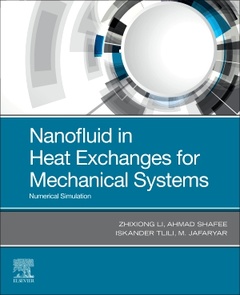Description
Nanofluid in Heat Exchangers for Mechanical Systems
Numerical Simulation
Authors: Li Zhixiong, Shafee Ahmad, Tlili Iskander, Jafaryar M.
Language: English
Subjects for Nanofluid in Heat Exchangers for Mechanical Systems:
Keywords
20th century; 24-Hour food recall; Adaptive thermogenesis; Adolescence; Adult; Affordability; Alcohol; Anemia; Anorexia nervosa; Appetite; Assessment; Atherosclerotic cardiovascular disease; Athlete; Australia; Autoimmune diseases; Automatic dietary monitoring; Bariatric surgery; Binge eating disorder; Birth weight; Blood pressure; Body composition; Body weight; Breastfeeding; Bulimia nervosa; Calorie deficits; Calorie targets; Canada; Cancer; Cancer cachexia; Carbohydrate; Cardiovascular disease risk; Cardiovascular diseases; Celiac disease; Child; Childhood; Chronic; Complementary foods; Convenience; Cost; Critical care nutrition; Critical illness; Cystic fibrosis; Data-driven methods; Diabetes; Diet; Diet history; Diet quality index; Dietary assessment; Dietary calcium; Dietary guidelines; Dietary intake; Dietary patterns; Dietary patterns in pregnancy; Dietary protein; Dietary reference intake
174.92 €
In Print (Delivery period: 14 days).
Add to cart366 p. · 19x23.3 cm · Paperback
Description
/li>Contents
/li>Readership
/li>Biography
/li>Comment
/li>
Nanofluid in Heat Exchanges for Mechanical Systems: Numerical Simulation shows how the finite volume method is used to simulate various applications of heat exchanges. Heat transfer enhancement methods are introduced in detail, along with a hydrothermal analysis and second law approaches for heat exchanges. The melting process in heat exchanges is also covered, as is the influence of variable magnetic fields on the performance of heat exchange. This is an important reference source for materials scientists and mechanical engineers who are looking to understand the main ways that nanofluid flow is simulated and applied in industry.
1. Fundamentals of heat exchangers
2. Nanofluid for heat exchangers
3. Heat exchanger equipped with various helical turbulators
4. Entropy generation due to inserting various helical swirl flow devices
5. Exergy behavior for heat exchanger in a pipe with modified turbulators
6. Unsteady process in a heat exchanger during melting
7. Air heat exchanger storage unit
8. Exhaust heat recovery heat exchanger of gasoline engine
9. Ferrohydrodynamic nanofluid in heat exchangers
10. Solar heat exchanger with twist tape
Materials scientists and mechanical engineers, mathematical scientists who are interested in numerical simulation
Lecturer at Public Authority of Applied Education and Training - College of Technological Studies - Applied Science department in Kuwait since 2010. Before that, dr. Shafee worked at Kuwait University. His research interests are Ordinary Differential Equations, Special Functions, Nanofluid, CFD, simulation, Mesoscopic modeling, Nonlinear Science, Magnetohydrodynamic, Ferrohydrodynamic, Electrohydrodynamic and Heat exchangers. He has written many papers and holds a part time position in Vietnam.
Dr Iskander Tlili, Associate Professor at Majmaah University KSA, completed his M.Sc. and Ph.D degrees in Thermal Energy at the Laboratory Studies of Thermal and Energy Systems, National Engineering School of Monastir, Tunisia. He has more than 18 years of teaching and research experience in Thermo-Fluid, Thermal Power, Renewable Energy and Desalination. He participated in the implementation of several Energy Audits. Dr. Iskander has published also many papers in highly reputed journals. He has been conferred with internal and external grants from different international sponsors and led several units and committees at both college and university level.
Mehrdad Jafaryar works at the Renewable energy systems and nanofluid applications in heat transfer Laboratory, Babol, Iran. His research interests are CFD, experimental investigation, analytical solution
- Provides detailed coverage of major models used in nanofluid analysis, including the finite volume method, governing equations for turbulent flow, and equations of nanofluid in presence of variable magnetic field
- Offers detailed coverage of swirling flow devices and melting processes
- Assesses which models should be applied in which situations




